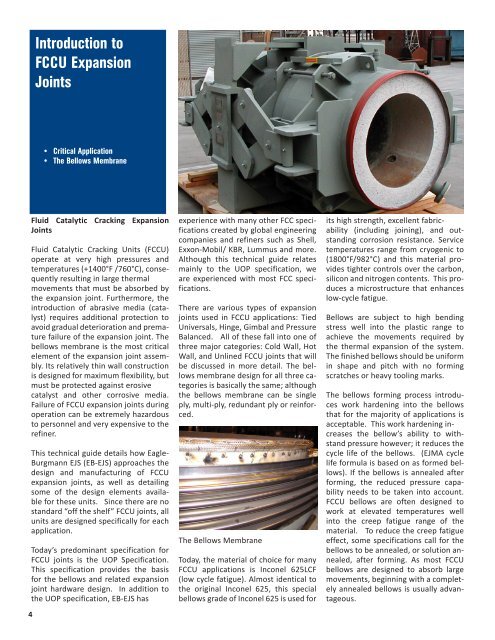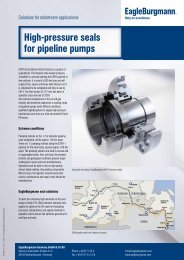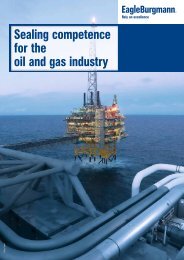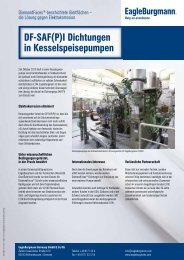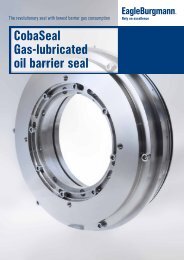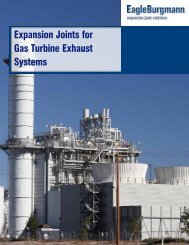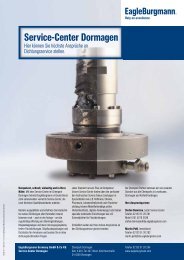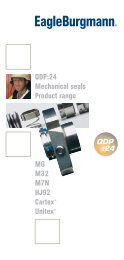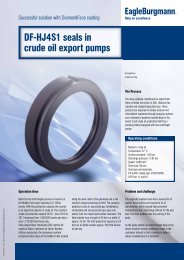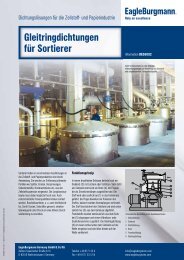Emergency Services - EagleBurgmann
Emergency Services - EagleBurgmann
Emergency Services - EagleBurgmann
You also want an ePaper? Increase the reach of your titles
YUMPU automatically turns print PDFs into web optimized ePapers that Google loves.
4<br />
Introduction to<br />
FCCU Expansion<br />
Joints<br />
• Critical Application<br />
• The Bellows Membrane<br />
Fluid Catalytic Cracking Expansion<br />
Joints<br />
Fluid Catalytic Cracking Units (FCCU)<br />
operate at very high pressures and<br />
temperatures (+1400°F /760°C), consequently<br />
resulting in large thermal<br />
movements that must be absorbed by<br />
the expansion joint. Furthermore, the<br />
introduction of abrasive media (catalyst)<br />
requires additional protection to<br />
avoid gradual deterioration and premature<br />
failure of the expansion joint. The<br />
bellows membrane is the most critical<br />
element of the expansion joint assembly.<br />
Its relatively thin wall construction<br />
is designed for maximum flexibility, but<br />
must be protected against erosive<br />
catalyst and other corrosive media.<br />
Failure of FCCU expansion joints during<br />
operation can be extremely hazardous<br />
to personnel and very expensive to the<br />
refiner.<br />
This technical guide details how Eagle-<br />
Burgmann EJS (EB-EJS) approaches the<br />
design and manufacturing of FCCU<br />
expansion joints, as well as detailing<br />
some of the design elements available<br />
for these units. Since there are no<br />
standard “off the shelf” FCCU joints, all<br />
units are designed specifically for each<br />
application.<br />
Today’s predominant specification for<br />
FCCU joints is the UOP Specification.<br />
This specification provides the basis<br />
for the bellows and related expansion<br />
joint hardware design. In addition to<br />
the UOP specification, EB-EJS has<br />
experience with many other FCC specifications<br />
created by global engineering<br />
companies and refiners such as Shell,<br />
Exxon-Mobil/ KBR, Lummus and more.<br />
Although this technical guide relates<br />
mainly to the UOP specification, we<br />
are experienced with most FCC specifications.<br />
There are various types of expansion<br />
joints used in FCCU applications: Tied<br />
Universals, Hinge, Gimbal and Pressure<br />
Balanced. All of these fall into one of<br />
three major categories: Cold Wall, Hot<br />
Wall, and Unlined FCCU joints that will<br />
be discussed in more detail. The bellows<br />
membrane design for all three categories<br />
is basically the same; although<br />
the bellows membrane can be single<br />
ply, multi-ply, redundant ply or reinforced.<br />
The Bellows Membrane<br />
Today, the material of choice for many<br />
FCCU applications is Inconel 625LCF<br />
(low cycle fatigue). Almost identical to<br />
the original Inconel 625, this special<br />
bellows grade of Inconel 625 is used for<br />
its high strength, excellent fabricability<br />
(including joining), and outstanding<br />
corrosion resistance. Service<br />
temperatures range from cryogenic to<br />
(1800°F/982°C) and this material provides<br />
tighter controls over the carbon,<br />
silicon and nitrogen contents. This produces<br />
a microstructure that enhances<br />
low-cycle fatigue.<br />
Bellows are subject to high bending<br />
stress well into the plastic range to<br />
achieve the movements required by<br />
the thermal expansion of the system.<br />
The finished bellows should be uniform<br />
in shape and pitch with no forming<br />
scratches or heavy tooling marks.<br />
The bellows forming process introduces<br />
work hardening into the bellows<br />
that for the majority of applications is<br />
acceptable. This work hardening increases<br />
the bellow’s ability to withstand<br />
pressure however; it reduces the<br />
cycle life of the bellows. (EJMA cycle<br />
life formula is based on as formed bellows).<br />
If the bellows is annealed after<br />
forming, the reduced pressure capability<br />
needs to be taken into account.<br />
FCCU bellows are often designed to<br />
work at elevated temperatures well<br />
into the creep fatigue range of the<br />
material. To reduce the creep fatigue<br />
effect, some specifications call for the<br />
bellows to be annealed, or solution annealed,<br />
after forming. As most FCCU<br />
bellows are designed to absorb large<br />
movements, beginning with a completely<br />
annealed bellows is usually advantageous.


